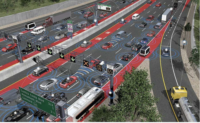The prospect of an infrastructure-focused, business-friendly administration in Washington, D.C., may bode well for the construction industry, analysts say, but opinions are mixed as to whether it will lift sales of equipment out of a two-year-long slump.
In the weeks leading up to Election Day, market specialist Chuck Yengst had forecast a slight sales uptick in 2017, pointing to an end to the protracted presidential race and construction market demand finally catching up with overstocked rental fleets. Now, following the GOP sweep of Congress and the White House, Yengst says the potential for tax cuts and reduced regulation brightens the outlook. “I can’t say by how much,” Yengst cautions, suggesting a potential 4% to 7% boost, “but 2017 will be better.”
|
Click Here to View the 4Q Cost Report PDF |
Chris Sleight, senior consultant for U.K.-based market consultant Off-Highway Research, projects a 4% increase in North America equipment sales, driven by a rebound in commodity prices from their January 2016 low and overall GDP growth in the U.S. and worldwide. “Our outlook is for continued single-digit annual growth in machine sales,” he adds.
The election outcome won’t cure all equipment-market woes, with energy and mining sectors still depressed. While self-funding infrastructure construction programs have begun in several states, the limited effect, so far, of the Fixing America’s Surface Transportation Act (FAST) could be further muted by Congress’ postponement, at least until April, of a scheduled $4.2-billion spending increase. That adds up to an improved, yet still negative, growth year for equipment sales, concludes Frank Manfredi, publisher of the Machinery Outlook newsletter. He says market enthusiasm about President-elect Donald Trump may help to generate some amount of new spending or investment, “but it won’t be a lot.”
More clarity will come next fall, when the Trump administration “puts its stamp on the federal budget,” Manfredi adds. Rental firms are expected to remain the primary construction-equipment buyers in 2017. But Dennis Slater, president of the Association of Equipment Managers, doesn’t expect increased demand to translate into higher unit costs. “It’s just my perception, but in light of market conditions, costs will remain steady,” he says.
One factor that could spark interest in new equipment is the machines’ increased technological sophistication, which Slater says helps contractors to compensate for skilled-labor gaps. He also cites growing interest in telematics systems, such as Komatsu’s Komtrax, to monitor equipment productivity in real time—a change from just five years ago, when equipment owners had yet fully to grasp the technology’s potential. “Now, we’ve reached the tipping point where contractors realize they need more precise data on equipment use to make decisions,” he says.
The generally upbeat 2017 equipment outlook is not without potential volatility. Steve Tam, vice president of ACT Research, says the current seven-year-old economic expansion “is getting long in the tooth” and the short-term benefits of increased spending and tax cuts could increase recession risk. “Three to four years out, it could be a very different picture,” he says, adding that, as far as a near-term threat goes, “it’s lurking in the shadows and not getting much attention.”




.jpg?height=200&t=1640294757&width=200)
Post a comment to this article
Report Abusive Comment